Fountain PumpsThe pump is the unseen heart of your fountain, water feature or koi pond Submerged in the reservoir, the pump draws water into its housing, where an impeller (a water propeller spun by electricity) forces the water out through the pump’s outflow fitting. Vinyl hose carries the recirculating water from the pump to the fountain piece where the water emerges again. Most pumps have a flow control mechanism to regulate the outflow of water. By adjusting the rate of flow, you can achieve different effects and eliminate unwanted splashing. Most small pumps come with rubber or plastic feet to help cushion them and/or hold them in place. Or they might be held in place by other items in the fountain. It usually doesn’t matter whether your pump will sit on its feet or lie on its side, as long as there is plenty of water covering the intake surface. Pumps can be left operating around the clock safely. Remember to keep the pump submerged under water. And, since water helps conduct electricity, it’s prudent to dry your hands thoroughly before plugging in the pump. (See "Safety Thoughts" in "Where to Set Your Fountain.") Keep It Submerged Safety Note: Submersible pumps are not designed to work in air and should ONLY be used when covered with water. Never let your pump run dry (run without water flowing through it) or you could ruin it! Turn off the fountain pump if you're going to be away for a prolonged time (thus, unavailable to monitor and replenish the water). Low Maintenance Pump Noise Sometimes noise is amplified through furniture, such as a wooden table. To minimize this effect, set the fountain on a sheet of cork, felt, or foam, or on a square of carpet or an old mouse pad. The amount of sound made by the water also affects how much you hear any pump sound. The more sound your flowing fountain makes, the less you will hear the pump. Water running over a smooth surface doesn't produce much sound. Water running over a rougher surface makes more sound. Water falling free into a pool makes even more sound. Often a faster rate of flow will produce more sound, also. (Avoid a flow which produces unwanted splashing, though.) |

